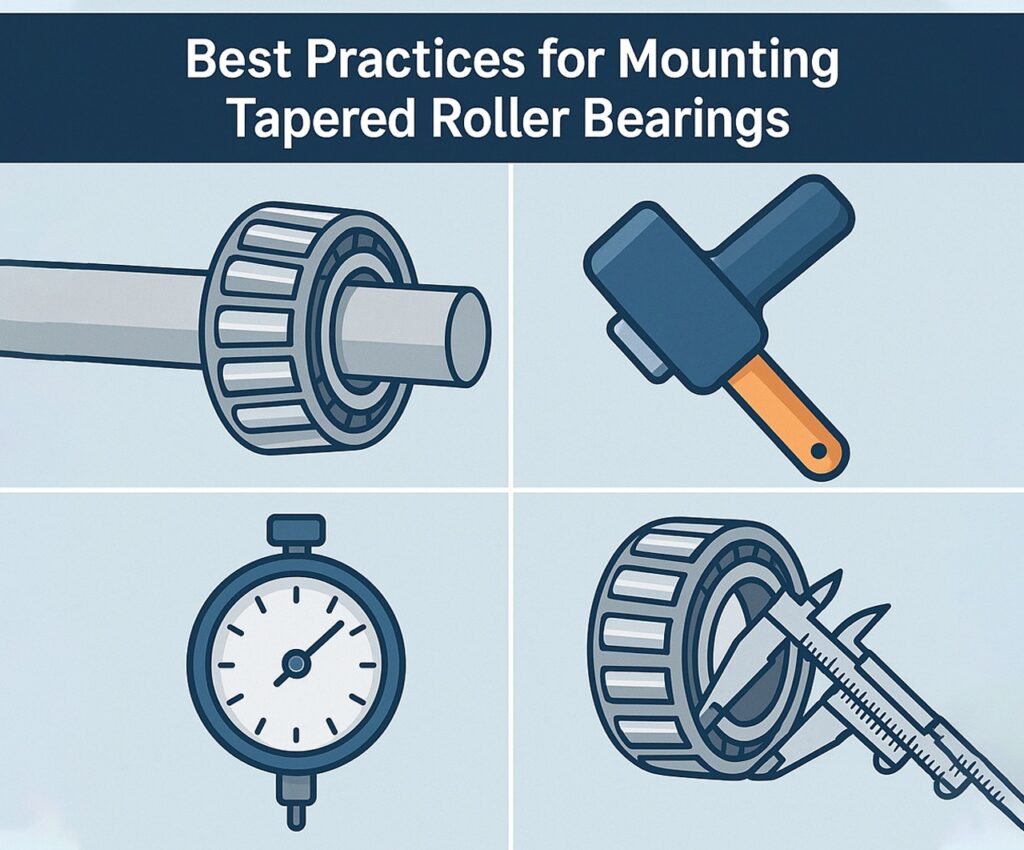When it comes to reliability and performance in rotating equipment, Mounting Tapered Roller Bearings properly can make or break the operation. Whether you’re working with a 30206 tapered roller bearing, installing a double row tapered roller bearing in a high-load gearbox, or fine-tuning alignment on a small tapered roller bearing in compact machinery, correct installation is essential. Improper mounting is one of the most common causes of premature bearing failure, making this process a top priority for maintenance technicians and engineers alike.
In this article, we’ll cover best practices for mounting tapered roller bearings of all sizes and configurations. We’ll also look at how specific bearing types like the 30206 tapered roller bearing and double row tapered roller bearing should be handled to ensure optimal load support and extended service life. Know More
Why Proper Mounting Matters
Tapered roller bearings are engineered to carry combined radial and axial loads. The precision of the internal geometry—taper angles, contact lines, and preload capacity—relies heavily on accurate mounting. When incorrectly installed, even a small tapered roller bearing can suffer misalignment, increased friction, overheating, and premature failure.
Proper mounting ensures:
- Correct preload and endplay
- Uniform load distribution across rollers
- Maximum contact efficiency between raceways
- Extended operational life
Step-by-Step Guide to Mounting Tapered Roller Bearings
1. Preparation and Inspection
Start with a clean workspace and ensure all components are free of contaminants.
Check the following:
- Shaft and housing surfaces for wear or scoring
- Dimensional tolerances
- Cleanliness of the 30206 tapered roller bearing or other selected unit
Never mount a bearing that has visible damage, corrosion, or is out of spec.
2. Orientation Awareness
Tapered bearings are directional. The large end of the cone (inner ring) must face the shoulder of the shaft to properly support axial load.
Pro Tip: On a double row tapered roller bearing, confirm the back-to-back (DB) or face-to-face (DF) arrangement based on application design.
3. Proper Heating (If Required)
For interference fits, gently heat the bearing cone using an induction heater or an oil bath (not exceeding 120°C or 248°F).
Never use an open flame, as it can damage the bearing structure.
4. Use Precision Mounting Tools
Avoid hammering bearings directly. Instead, use:
- Hydraulic or mechanical presses
- Sleeve and arbor press tools
- Precision mounting sleeves for small tapered roller bearing applications
These tools help apply even pressure without damaging races or rollers.
5. Setting the Preload or Endplay
This step is critical. Tapered bearings require a specific axial clearance or preload for optimal function.
General rules:
- Too tight = overheating and premature wear
- Too loose = excessive vibration and misalignment
Use feeler gauges, dial indicators, or torque measurements to set proper values.
6. Apply Lubrication
Depending on the application, choose between:
- Grease (for slow to moderate speeds)
- Oil bath or circulating oil (for high-speed or high-load systems)
- Apply lubricant evenly around all rolling elements. For high-performance units like the 30206 tapered roller bearing, ensure the lubricant matches OEM recommendations.
7. Check for Axial Movement
After mounting, rotate the shaft by hand to check for smoothness and confirm proper endplay. Re-check after system has reached operating temperature to account for thermal expansion.
Application-Specific Tips
30206 Tapered Roller Bearing
This is a commonly used metric-size bearing in automotive hubs, industrial gearboxes, and power tools.
Best practices:
- Ensure shaft and housing seats match ISO tolerances
- Avoid excessive preload in wheel applications
- Grease packing should be uniform across the cage
Double Row Tapered Roller Bearing
Used in heavy-duty applications like rolling mills and mining equipment, these bearings handle axial and radial loads in both directions.
Tips:
- Mount using precise orientation to ensure correct internal geometry
- Use split housings to simplify replacement
- Set preload using axial shims or spring-loaded systems
Small Tapered Roller Bearing
Common in electric motors, precision tools, and miniature gear systems.
Tips:
- Avoid overheating during press fit; use ambient or warm fit
- Precision is more critical at this scale—small errors have bigger consequences
- Use light preload settings to reduce rolling resistance
Avoiding Common Mistakes
- Skipping the Cleanliness Check A speck of dirt or grit can lead to premature wear. Always clean and inspect.
- Overheating the Bearing Never heat above 120°C unless approved by the manufacturer.
- Incorrect Endplay Too much or too little endplay leads to uneven load distribution.
- Using Inappropriate Tools Avoid prying or hammering. Even a small tapered roller bearing can be damaged easily with the wrong tool.
Innovations in Mounting Technology
Modern tools and techniques are improving the way bearings are installed:
- Induction Heating Units: Provide uniform, controlled heat
- Laser Shaft Alignment Systems: Ensure perfect positioning
- Digital Preload Measurement Devices: Replace subjective feeler gauges
Manufacturers of double row tapered roller bearing assemblies are also integrating smart sensors to monitor preload and alignment in real time.
Storage and Handling Tips
Even before mounting, proper storage is key. Always:
- Keep bearings in original packaging until use
- Store in a dry, vibration-free environment
- Avoid contact with dirty or rough surfaces
When handling a 30206 tapered roller bearing, always support both the inner and outer rings to avoid stress on the rollers.
Final Inspection After Mounting
Once mounted:
- Rotate the shaft by hand
- Listen for noise or vibration
- Check alignment and torque specs
In high-performance systems, test under actual operating conditions and verify temperature rise and endplay stability over time.
Final Thoughts
Mounting a tapered roller bearing isn’t just a step in assembly—it’s a critical factor in the bearing’s lifecycle. Whether you’re dealing with a 30206 tapered roller bearing, a large double row tapered roller bearing, or a compact small tapered roller bearing, precision, patience, and best practices are your best tools.
By following the procedures outlined above, you ensure longer bearing life, reduced downtime, and better performance across all applications.

